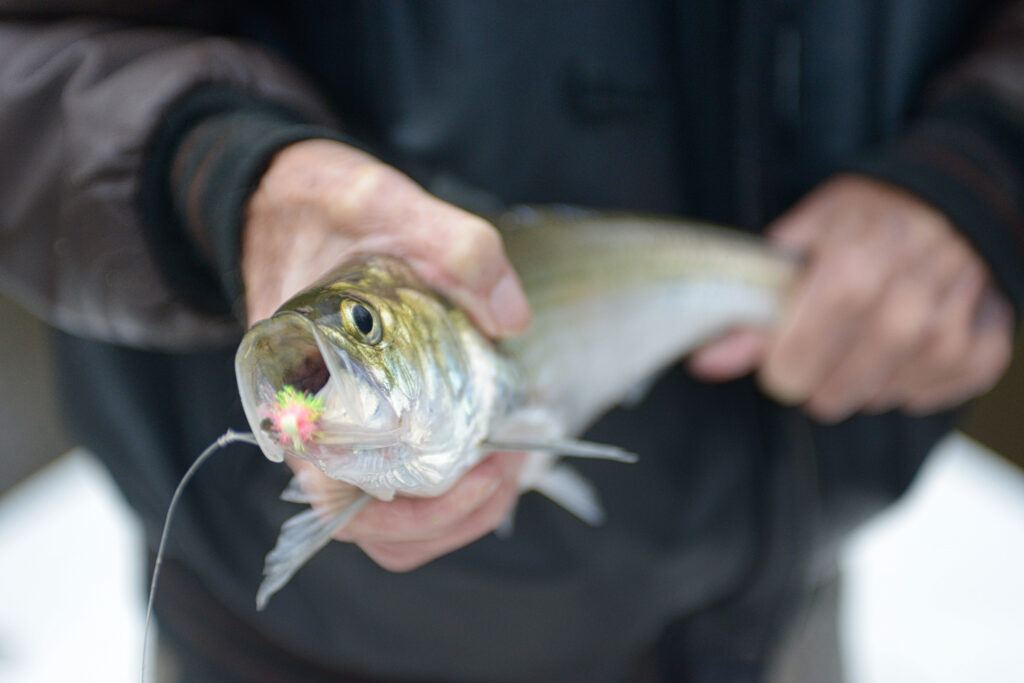There is a disconnect in Virginia’s fishing regulations regarding hickory shad, and a group of anglers is trying to get it fixed.
On hickory shad, the Virginia Division of Wildlife Resources (DWR) states “Creel and length limits shall be the same as those set by the Virginia Marine Resources Commission (VMRC).” But VMRC has not set any regulations for hickory shad. In essence, there are no protections for hickory shad in the Virginia portion of the Chesapeake Bay, including rivers and tributaries.
Wayne Young, a volunteer with the Coastal Conservation Association (CCA) of Virginia doesn’t know if the lack of hickory shad regulations in Virginia’s coastal waters is intentional or just a simple oversight. But he’s launched a new petition calling for rules to be put in place.
If you ever caught a hickory shad, you’d remember it. They are small, silvery fish that jump repeatedly and fight hard. They will remind you of baby tarpon. They are anadromous, meaning they spawn in fresh water but spend most of their adult lives at sea. They range from Florida to Maine on the East Coast and are most abundant in the Carolinas and Virginia.
Hickory shad are not very large, averaging 13 to 15 inches depending on sex. They can be distinguished from other members of their family by a protruding, tarpon-like lower jaw. The Atlantic States Marine Fisheries Commission lists the species as depleted.
In the Chesapeake Bay, they are abundant in the spring, when they enter rivers to spawn. In Maryland, the Susquehanna River is popular for shad chasers. In Virginia, they can be found in all of the western rivers, with the Rappahannock and James rivers being quite popular. While not part of the Chesapeake Bay watershed, the Nottoway River is also a Virginia hot spot.
In Virginia, it is illegal to possess the hickory shad’s relatives, such as American shad and blueback herring. Most anglers who chase hickory shad regularly practice catch-and-release. Those who keep shad use them for catfish bait or eat the roe, which many consider a delicacy.
Back in 1980, there was a statewide moratorium on the harvest of hickory shad in Maryland waters to aid State and coast-wide recovery efforts. Today in Maryland, recreational catch-and-release fishing is allowed for hickory shad.
Virginia waters still have no limits of size or number of hickory shad an angler can take, nor any restrictions on the type of gear one can use to catch them. CCA Virginia is trying to fix this. In a recent press release they note, “Hickory shad are fully protected in Maryland and DC waters and there is a 10-fish daily bag limit in North Carolina (though no size limit) and selected Virginia rivers beyond the Chesapeake Bay watershed.”
CCA says it is concerned that “unrestricted catches in Virginia’s coastal rivers threaten progress made to protect and restore both shad species, which are also forage for striped bass and other Bay game fish.”
After having little success advocating for regulations over the past few years, the anglers’ conservation group is now trying a new approach. Virginia has a town hall website where citizens can petition for rule making, and can comment on and follow proposed regulations. CCA filed a formal petition for rulemaking to the VMRC, requesting that the Commission consider reasonable harvest regulations for hickory shad in Virginia waters under its jurisdiction.
According to Young, VMRC has already responded favorably to the petition. VMRC says the suggestion might bypass the town hall website and go directly to the agency for action.
According to Young, “Our request could go directly into rulemaking rather than via petition. This includes consideration by the Finfish Management Advisory Committee and then a public hearing. We understand that there is public comment opportunity for each.”
The public comment period for hickory shad regulations is not open yet, but there may be an opportunity to comment in the future. The best way to stay informed as this evolves is to follow CCA’s Facebook page or on their website.




